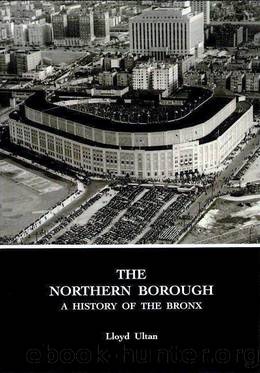The Northern Borough: A History of The Bronx by Lloyd Ultan

Author:Lloyd Ultan [Ultan, Lloyd]
Language: eng
Format: mobi
Published: 2011-04-09T00:00:00+00:00
Public Transportation
Developers in the Annexed District supported the creation of parkland because they believed, with Mullaly, that this amenity would help attract more people to the area and would increase land values. Nevertheless, the transportation system needed great improvement to facilitate the movement between the business districts of the city and the mainland if the North Side were to grow into a full-fledged part of the metropolis.
Until the 1880s, the Districtâs residents had few options if they had to commute to Manhattan. A system of side paddle steamships plied the Harlem River. Commuters could board at Fordham Landing, at Morris Dock (which had been built years earlier by Lewis Gouverneur Morris), High Bridge and Mott Haven. This commute to the heart of the city was leisurely. The existence of the steamship line did foster the development of the shoreline near the High Bridge. Because the spectacular structure had become a tourist attraction, a few hotels opened just south of the span to accommodate those who wished to stay longer than one day. Nearby, an amusement park opened with the dock over which day trippers from the more crowded city neighborhoods disgorged.
The New York and Harlem River Railroad, and the New York and Hudson River Railroad of the New York Central System, provided faster access to Manhattan than the steamships. These railroads served the wealthy residents in the two Riverdales and the same customers as the steamships. The old towns of Morrisania and West Farms that had been built up by the Harlem River line had practically reached the limit of development it had provided. Railroad commuting was too high on a daily basis for most of the people who still resided in Manhattan.
The presence of the railroad, however, still had an effect on the development of the new Woodlawn Heights north of the cemetery. At the time of the 1874 annexation, it was still sparsely settled. The railroadâs location was enough, however, for developer Edwin K. Willard to donate land on 237th Street between Kepler and Katonah avenues to build the Woodlawn Heights Methodist Episcopal Church in 1876. About the same time, the first school in Woodlawn opened for about forty students in classes up to the fifth grade, and the first grocery store opened in 1875.
The railroad in that area began to have an effect on the development of the east bank of the river, which it paralleled, starting in 1885. A small bridge was built to connect the western edge of the town of Eastchester with the Woodlawn station. This access to the railroad enabled small villages to grow east of the river. When the country celebrated the one hundredth anniversary of independence in 1876, the village to the north took the name Mount Vernon, the farm in Virginia where George Washington had lived. The area to the south took the name of Wakefield, the Virginia plantation where Washington was born. There was already a Washingtonville station on the railroad north of Wakefield. In the 1880s, Germans began coming into Wakefield to work at the farms.
Download
This site does not store any files on its server. We only index and link to content provided by other sites. Please contact the content providers to delete copyright contents if any and email us, we'll remove relevant links or contents immediately.
Deep learning with TensorFlow and Keras by Derrick mwiti(865)
Understanding PDA Autism in Kids: A Guide for Parents and Teachers to Support Neurodiverse Learners by Jehu Len(713)
The Victorian Era: A Captivating Guide to the Life of Queen Victoria and an Era in the History of the United Kingdom Known for Its Hierarchy-Based Social Order by Captivating History(496)
Intersectionality in Educational Research by Dannielle Joy Davis; James L. Olive; Rachelle J. Brunn-Bevel; Susan R. Jones(477)
100 Ideas for Secondary Teachers: Engaging Parents by Janet Goodall & Kathryn Weston(476)
How to be assertive in any situation by Hadfield Sue & Hasson Gill(459)
Writing Solid Code: Development Philosophies for Writing Bug-Free Programs by Steve Maguire(457)
Brain Teasers to Build Critical Thinking Skills: Brain Exercises for Tech, Banking, Case Interview Prep, and to Keep Your Mind Sharp by Kris Safarova(449)
Brain Teasers to Build Critical Thinking Skills by Safarova Kris(448)
Python 101 - Fundamentals by Sam(411)
Critical Curriculum Leadership : A Framework for Progressive Education by Rose M. Ylimaki(407)
The Art of Emotional Validation: Improve Your Communication Skills and Transform Your Relationships by Validating Emotions and Feelings by Emily Wright(377)
The Knights Templar: An Enthralling History of the Rise and Fall of the Most Influential Catholic Military Order by Wellman Billy(367)
The Future Knowledge Compendium by Ellyard Peter;(364)
A Beginner's Guide to SSD Firmware by Unknown(363)
What Every Teacher Should Know about Learning, Memory, and the Brain by Tileston Donna E. Walker;(360)
NumPy : From Basic to Advance by bisht Karan Singh(348)
Making Connections in and Through Arts-Based Educational Research by Hala Mreiwed Mindy R. Carter Sara Hashem Candace H. Blake-Amarante(342)
Foundations of Educational Research by Victoria Elliott(335)
